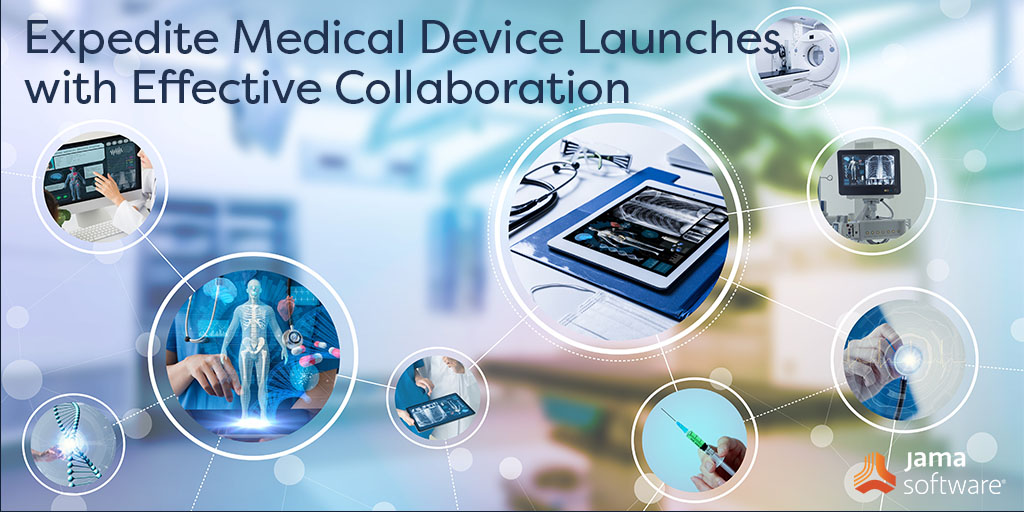Editor’s Note: In a time where remote collaboration and distributed teams are quickly becoming the norm rather than the exception, we’re proud to share this post on the value of effective collaboration around medical device design and product development. This article was originally published here on May 5th, 2020 by MedTech Intelligence and written by Jama‘s VP of Customer Success, Clay Moore.
How Effective Collaboration Can Expedite Medical Device Design
Medical device companies are committing significant resources to the fight against Covid-19. Collaboration tools can help expedite product design while supporting evolving compliance standards.
Weeks after the COVID-19 lockdown, medical device companies continue to face challenges as they manage remote engineering teams working rapidly to keep up with a changing environment. Now that the initial shock has passed, companies are becoming more well-versed in their new workplaces and identifying how to keep remote engineering teams working successfully.
Teams are under pressure to meet quality and compliance standards while staying on pace to hit delivery dates, and optimizing the efficiency of remote engineering teams as they develop complex devices can be difficult. Normally, products can undergo multi-month-long review cycles, which tie up valuable resources. Technology, when properly leveraged, can reduce that review cycle by as much as 75%—a vast improvement.1
Effectively streamlining collaboration is key to expedite design reviews and medical device product launches. The following is how companies can use collaborative technology to maximize output while meeting critical health standards.
Reduce Dependency on Documents
Medical device companies have been forced to come to terms with their current processes to see if they work for remote engineers. Most know that helpful technology exists, but platforms that promise to streamline lengthy processes can be intimidating. Companies that delayed digital adoption are especially disadvantaged.
The document-based requirements management approach often used by medical device companies limits visibility into the design process across teams. This makes it difficult to scale across multiple product lines and versions, especially with teams working remotely, and it increases expenses.
Collaborative requirements management software can help engineers easily communicate and smoothly define, review and validate information digitally to ensure projects are tracking and a clear path to compliance and launch is visible. Effective software reduces manual processes that limit innovation and add time to development.
Medical device companies should seek collaboration tools that help their engineers clearly communicate the path to launch, tasks and ownership, and current status and action items needed. Remote work on complex processes requires seamless communication and understanding where work is being bottlenecked so teams know how to direct their attention.
Stay On Top of Compliance
In the medical device industry, understanding current product regulations is key to shape the product development process. In recent weeks, the FDA has issued changes to its 510(k) program, and the European Parliament voted to delay the EU Medical Device Regulation.2,3 Companies who have a centralized approach and real-time access to requirements and design can minimize the added overhead of regulatory requirements, streamline development, and minimize risk.
When companies lack resources to efficiently locate regulatory standards and swiftly communicate them to engineers, they’re wasting time and limiting the ability to mitigate risk. Using traditional collaboration tools or Word documents to manage the product development process isn’t effective, leading to teams spending days or weeks to pull together documentation in preparation for an audit. Ensuring compliance requires context and visibility throughout the design process, and innovative tools that structure collaboration and put compliance and regulation at the forefront can provide both.
Good requirements management software uses a lifecycle approach to make sure compliance is integrated into the design process. Team members are held accountable, and workstreams keep track of when signoffs occurred.
Getting compliance right can be a challenge with engineers working remotely—but it is too important and too costly to get wrong. It can cost $600 million to recall a product.4
Remote Collaboration Sets Medical Device Companies Up for Success
Companies forced to embark on their digital transformation journey during this pandemic can save valuable time and money on product launches by embracing requirements management software to help streamline communication, structure collaboration, and ensure compliance.
This level of collaboration is more prevalent than ever, especially considering the state of work may change as we know it. In fact, a Gartner, Inc. survey revealed that 74% of CFOs and finance leaders will move at least five percent of their previously on-site workforce to permanently remote positions post-pandemic.5 Engineering teams need to make remote collaboration an effective part of their normal operating routines, starting now.
By embracing the right technologies, medical device companies are not only investing in supporting their teams at this crucial time but also they are investing in the success of taking products to market, as the world conducts more and more business online.
References
- “Case Study: Healthcare Leader Grifols Uses Jama Connect to Cut Costs and Speed Development”. (June 2019). Jama Software.
- “FDA Relaxes Rules on Ventilators for COVID-19”. (April 2020). The Regulation Review.
- “EU MDR: Parliament Overwhelmingly Backs One-Year Delay”. Regulatory Affairs Professionals Society.
- “The Business Case for Medical Device Quality”. (October 2013). McKinsey & Company.
- “Gartner CFO Survey Reveals 74% Intend to Shift Some Employees to Remote Work Permanently” Gartner, April 2020
READ MORE
- 2025 Expert Predictions for Medical Device & Life Sciences: Innovations in Patient-Centered Care and the Future of Medical Device Design - January 9, 2025
- Jama Connect® Enables DevSecOps Through Robust API and Integrations That Connect All Activity to Requirements - January 7, 2025
- 2025 Expert Predictions for Aerospace and Defense: AI, Sustainability, and the Next Frontier - January 2, 2025
